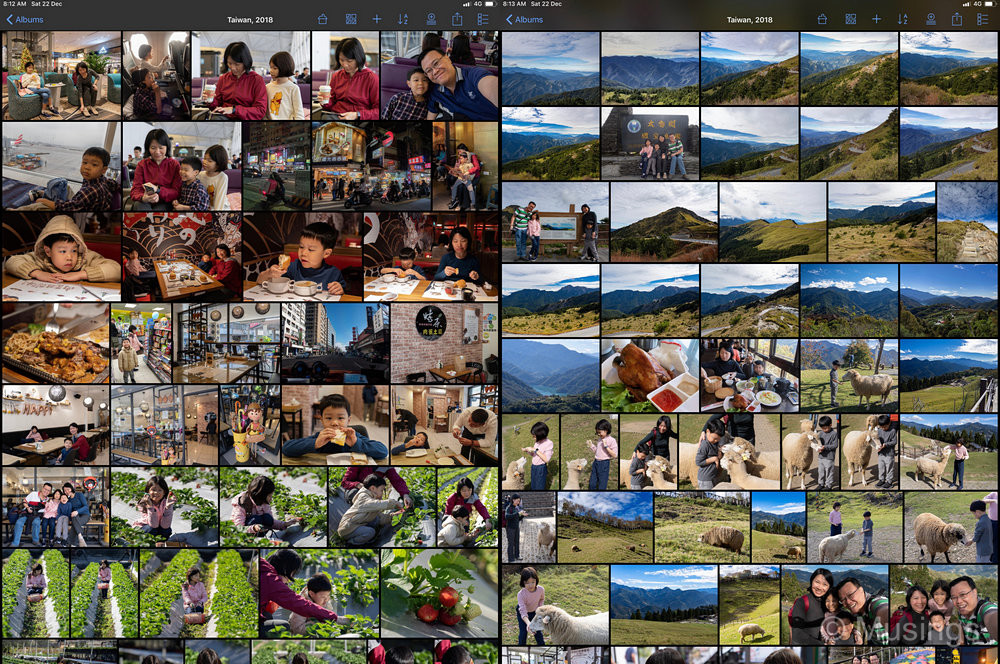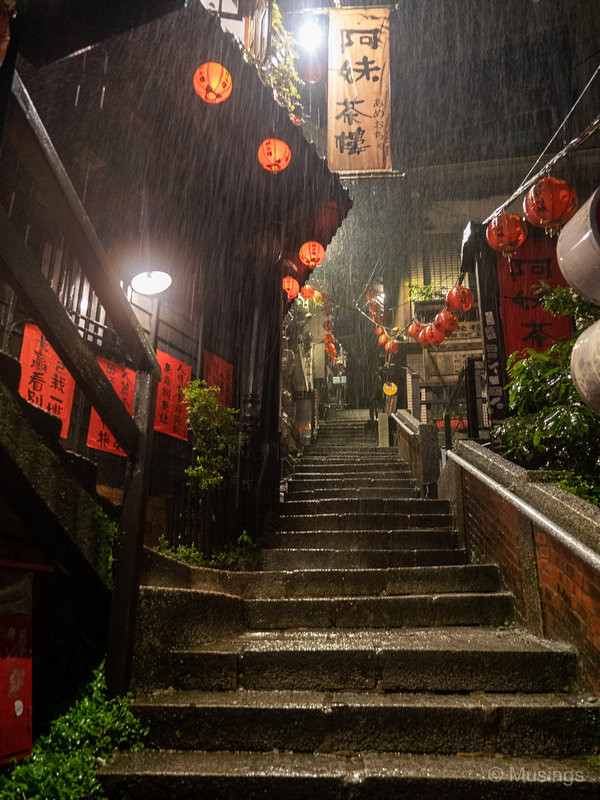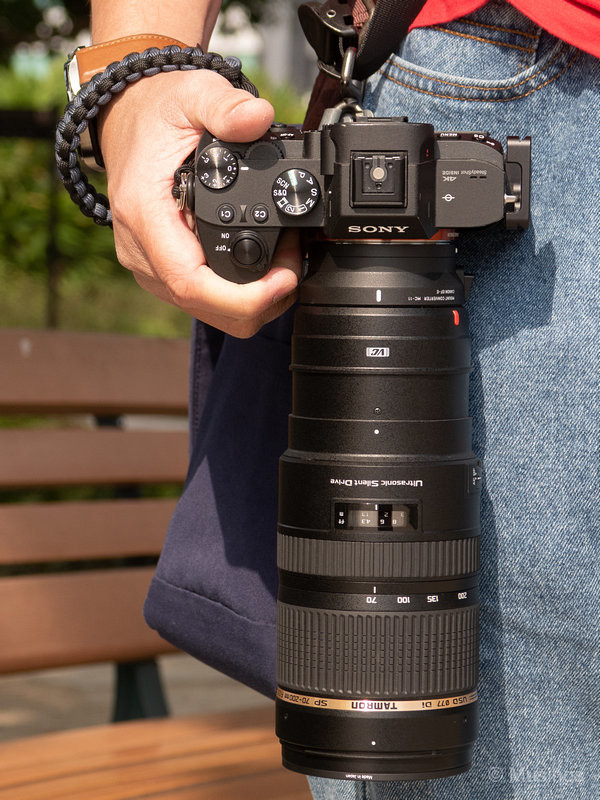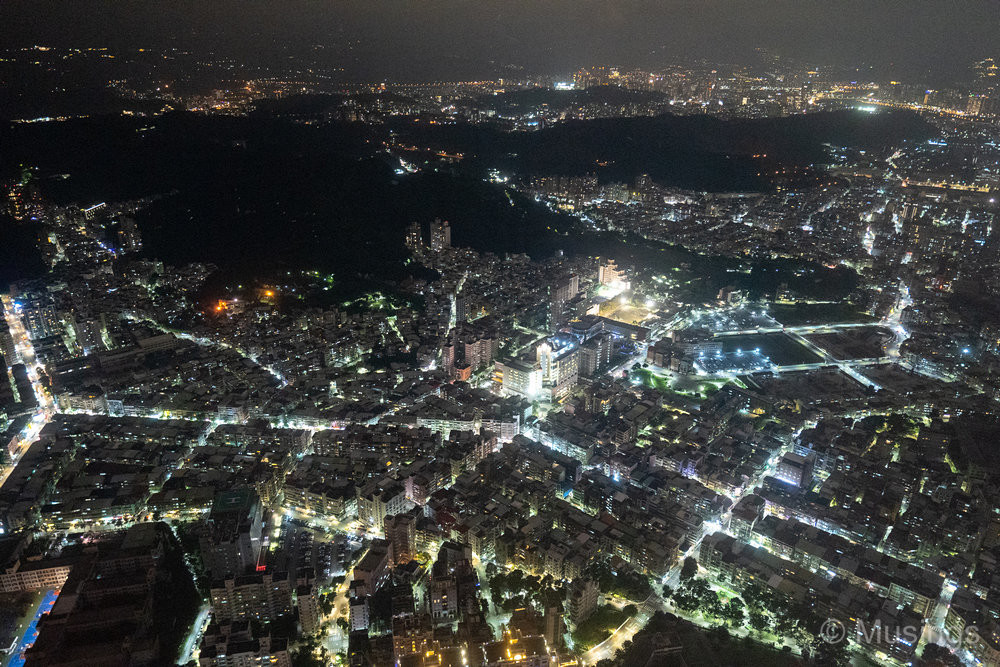There were more than a few occasions this Taiwan trip where I was invited to join the kids and Ling in taking part in our itinerary activities: e.g. strawberry and grape fruit picking, or a dip into the hot springs up on that foggy day @ Yangmingshan. I declined each time, chuckling that I’m really here just to take pictures! So, while working on the final itinerary reflection and trip retrospection posts, here’s an interim post on the photographic aspects of this trip.
The meta data I’ve got for this trip presents an evolving picture: that I’m very gradually relying more on the smartphone for quick shots, or when I don’t want to draw attention to the ILCs I’m using – and the two days of rainy weather on Days 8 and 9 during the Yehliu/Shifen/Jiufen/Yangmingshan segments of our trip meant that I had to exclusively use the Samsung Note 9 anyway. The Note 9, like the S8+ that’s with Ling now, is an IP68-certified camera i.e. easily waterproofed for use in the rain. That the lens piece is so small too meant that it was easy to wipe or shake off any water droplets on it that would have cause image distortions.
Numbers-wise:
Sony A73: 4,785 photos in .ARW RAW format
Samsung Note 9: 1,336 photos in a mix of JPG and .DNG RAW format + 182 videos in 4K 30fps video using the H.264 codec
Canon G7X II: 1,301 photos in .CR2 RAW format
I was surprised by the number of pictures I took on the G7X II this time. The little 1″ sensor compact really owns it when I’m looking for a compromise between getting decent enough images with enough headroom for me to do post-processing in Lightroom, and a simple camera for our drivers to take our family pictures with. The Note 9 of course is an even more accessible camera to foist on others, but the tiny imaging sensor in it just means that I need to get exposure exactly right as I have very little room to fix any errors, even when I set the Note 9 to take shots in .DNG RAW format.
Of the 7,422 photos I took this trip, I’m keeping 4,200 of them and all the videos – making up a staggering 148GB of data: 86.5GB of images and 61.7GB of video. That’s a keeper rate of 56.5%. If I use the next closest trip in comparison – our 11 day trip in Western Australia – I took 5,828 photos and kept 3,331 – a keeper rate of 57%. Pretty close! What’s interesting to me is that the a large number of pictures in WA were shot in drive mode – e.g. during the several animal feeding sessions, while I used the drive mode fairly sparingly this Taiwan trip. Which meant that there was a lot deliberate composition set-up this trip and deliberate shooting.

I also had two SD storage cards with me: the Samsung 128GB (U3) MicroSD EVO Select SD Card in the A73, a Sandisk Extreme 64GB in Canon G7X II, and the Samsung Note 9 has its 128GB internal memory. I nearly exhausted the space I had on the Samsung 128GB card, so note to self: bring along a few spare SD cards.

All three lenses performed very well again, with the real standout being the Sony FE 24-105mm f4.0 once more. There was an ongoing debate again in the Sony A73 Facebook group about the merits of the Tamron 28-75mm f2.8 against this 24-105mm, and most enthusiasts were preferring the former. But for myself, the principal use of the 24-105mm is in general purpose photography. And honestly, the additional reach I get on this lens easily surpasses the additional stop of light gathering one would get at f2.8. I might invest in a used copy of the Tamron 28-75mm at some point for within Singapore use – but if I’m stepping out of the country on vacation, it’s hard for me to imagine having a better companion than the 24-105mm.
The Tamron 70-200mm f2.8 + MC-11 was out on its first major use-case this trip, and its performance was a little mixed. The AF-C with tracking mode was unavailable, which made it challenging to take those shots of Hannah on the swing @ Da’an Forest Park. The birds at the sanctuary at the same park were no problems for the AF modes, as they were – for the most part – not moving, so I just need to wait for the correct facing before taking a shot. What was less impressive on the Tamron was center sharpness. I struggled to get the kind of center sharpness that this 70-200mm f2.8 is supposedly famous for, and had to do quite a bit of post-processing in Lightroom to fix an overall softness in the image. Still, the lens is a sexy-looking beast, and I got it new at a bargain price. And I’ve gotten some really nice pictures from it this trip.
All this said though, I’m going to give some thought to whether I should just bring my older but yet still trusty E-M1 + 40-150mm f2.8 setup next trip. The additional 100mm reach is nothing to sneeze at, and the Olympus 40-150mm f2.8 lens will work with all of E-M1’s AF modes. That’ll mean I’m back to lugging around a second body again. I’d save weight though: the E-M1 with the Olympus lens is 495 + 880g = 1,375g vs the Tamron 70-200mm f2.8 + MC-11 which is 1,470g + roughly 200g = 1,670g. I’ll be carrying more bulk though in the bag on the other hand.

The Sony FE 16-35mm f4.0 was the somewhat least-used lens, but that’s also relatively – because the number of exposures I took using it is roughly about 700 or so! The lens was used during the Cingjing sunrise shoot, and at Mt. Hehuan, Taroko Gorge, and Taipei 101 on the outside, the on Taipei 101’s Observation Decks. The lens focuses noticeably slower than the 24-105mm, so while the 16-35mm longest end covers the same range as the short end of the 24-105mm, I didn’t want to keep this lens mounted on the A73 for long when I was done with the wide shots.
And finally, what of the Sony A73? This has been the second family vacation where this ILC has been the principal image capturing device since I moved to full-frame in April this year. And like this year’s Bali trip, the camera has been incredible with a few idiosyncracies I’m still learning to work around. On the upside, the .ARW RAW files are really easy to work with, and I’ve pulled some crazy recovery stunts in post-processing for several shots where I severely underestimated exposure. The battery life is amazing, and coupled with the camera’s ability to charge on the fly via USB, I likely will just leave the spare battery at home next trip. Focusing is brisk using the 24-105mm, and toggling between modes is easy. I found myself shuttling between my custom set of parameters and Shutter-speed priority when I was on the Tamron 70-200mm, and switched around the focusing modes even more when I had off-center subjects.

On the flip-side, changing ISO is a little clunky, and the command dial is is rather fiddly. I reckon a bit more resistance in the command dial would have help loads. I had to over-ride the upper ISO limit – which I normally set to ISO3200 – during the night shoots up on Taipei 101’s Observation decks several times, as the amount of actual illumination dramatically differed as I went from tower facing to facing – and it was tough turning the dial to the exact ISO I wanted. It frequently overshot the ISO, or set it to something I didn’t want.
That the A73 and the lenses I currently have for it also aren’t weather-sealed also meant that I hesitated bringing it out during rain, and only when I knew that any shots I’d try on the waterproof Note 9 will turn out to be imaging mush. By that, I especially meant the evening and night shoots of Jiufen Old Street. Now that I’m back in Singapore, the Sony A73 and 24-105mm looks to have completely shrugged off the numerous water droplets splashing on it that night – so it looks like I’m in the clear!
After a reminder from our Ang Mo bud, I bought the Samsung Gear 360 – but it never left the luggage case. I reckon I just had too much equipment to use at this point!
And so, finally lessons for the next trip:
Bring the A73 and all three two zoom lenses: the 24-105mm f4.0 and the Sony FE 16-35mm f4.0
Consider carefully if I should bring the Olympus E-M1 + 40-150mm f2.8 and not the Tamron 700-200mm f2.8.
Keep the A73 base cage on it: it saved the A73’s bacon a few times, and will continue to do so.
Ditch the remote triggers. Didn’t have a use for them.
Continue to leave the A73 battery grip at home. Takes up too much bulk!
Bring spare SD cards of 32GB space and more.
Leave the spare A73 battery alone if I need to trim luggage. The A73’s support for USB charging makes it unnecessary to carry a spare.
I’ll do another related post later commenting on some of the post-processing work I did in Lightroom this trip. In the mean time, who wants to buy my slightly used Samsung Gear 360 LOL?
That’s an impressive keeper rate! (That is also my favorite Jiufen Old Street shot!) It seems you’re really nailing down your camera gear considerations toward future travel.
By the way, I expect you packed the majority of your operating camera equipment in your carry on luggage, yes? Were you close to or above the airline’s mandated carry on weight restrictions? I’ve only run into this being a problem—and a mighty big one—when traveling out of Australia. I’m fascinated in how traveling photographers manage those restrictions without buying a secured Pelican case and checking the luggage.
Yep, bud there is – it’s 7kg I think normally for economy class. But all of my camera equipment this trip – even the Samsung Gear 360 which I ended up not using haha – was in carry-on baggage, alongside anything that’s not normally permitted to be check-in luggage i.e. batteries. Inside that Thule Subterra Backpack 30L was also the Thinkpad X1 Carbon and also iPad Mini, and I think it comes close to or is right about 7kg this trip.
But I’ve never seen anyone get their carry-on luggage weighed, and some passengers really take it to the extreme with their hard cases designed to fit exactly into the overhead compartments, and from the way they struggle to lift it to the overheads, it probably weighs well more than 7kg.
Odd you had that experience in Australia. The trip to WA last year, I had two m4/3s (the GX85 + E-M1), all my batteries, and two lenses between them, two iPads, and the X1 Carbon – and I had no issues getting in or out of Australia.